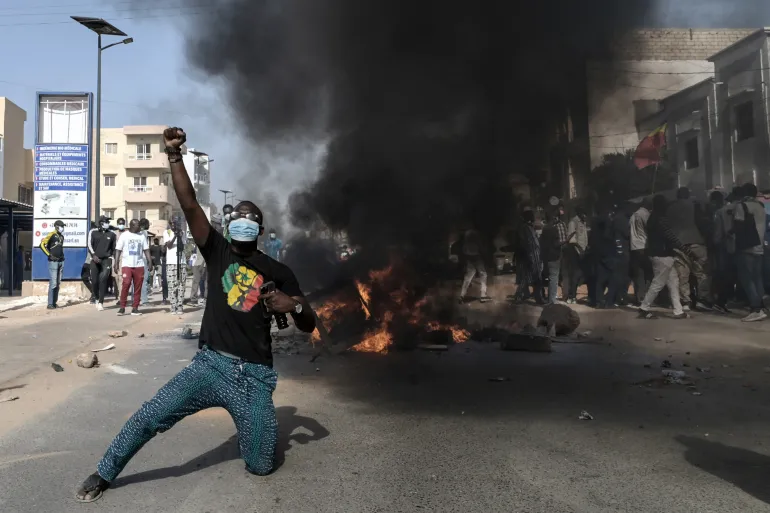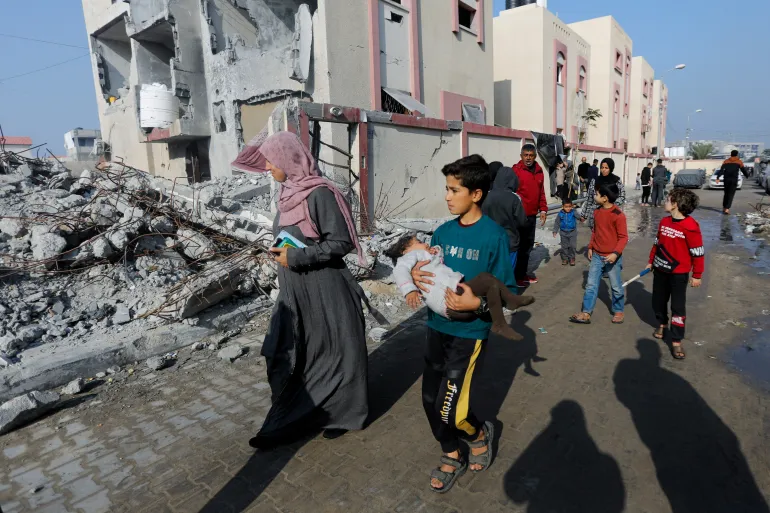Manipur’s BJP CM inflamed conflict: Assam Rifles report on India violence
Manipur’s BJP CM inflamed conflict: It also points to the role of armed groups from the Meitei and Kuki-Zo communities in the prolonged violence in northeastern India.

Houses vandalised and burned in Torbung Bangla, the village where the violence started in Manipur, India, 11 months ago [Angana Chakrabarti/Al Jazeera]
Kangpokpi/Imphal, India – On Christmas Eve, it was eerily calm inside a makeshift bunker with piles of gunny bags and a tin roof. Hunkered inside and clutching their single-barrelled rifles, 19-year-old Chonminlal Kipgen and 26-year-old Paolal Kipgen from the predominantly Christian Kuki-Zo community looked out and scoured the hills of Kangpokpi district for armed fighters from the rival Meitei community.
They said they were village volunteers – civilians who had taken up arms to defend their homes.
KEEP READING
- Modi’s BJP promises jobs, common civil code in manifesto for India election
- Before India election, Instagram boosts Modi AI images that violate rules
- ‘We’re a single village’: India seals Myanmar border, dividing families
- Why a Sri Lankan island is sparking an Indian election controversy
Not so far away in Manipur’s capital, Imphal, the majority-Meitei community had similarly muted celebrations during their most cherished festival, Ningol Chakouba, in early November.
For the past 11 months, the two communities in India’s northeastern state of Manipur have been locked in what is arguably the country’s longest-running ethnic conflict in the 21st century under the watch of a federal government headed by Prime Minister Narendra Modi.
The conflict has killed 219 people, injured 1,100 and displaced 60,000. It has revived an array of armed groups, sweeping up men and boys as recruits from both communities. On Saturday, two Kuki-Zo “village volunteers” were killed and their bodies allegedly mutilated in Manipur’s Kangpokpi district. In their press release, tribal groups accused “central security forces, who aided Meitei militants” of being behind the killings.
The conflict is frequently oversimplified as a struggle between the Hindu Meitei and Christian Kuki-Zo communities, mirroring the religious polarisation seen in communal conflicts and assaults on religious minorities in various parts of India. While the Kuki-Zo communities are almost entirely Christian, the Meitei community predominantly follows a syncretic form of Hinduism and their own Indigenous faith system, called Sanamahism. A smaller number of Meitei people also follow Christianity and Islam.

But an assessment prepared by Assam Rifles officials in Manipur highlighted a different set of factors that are unique to the conflict in Manipur. The Assam Rifles is the federal government’s paramilitary force with a long and controversial history in the state. It is the oldest paramilitary force in the country and shoulders the responsibility of maintaining law and order in the northeast along with the army.
The Reporters’ Collective (TRC) reviewed the assessment, made in a PowerPoint presentation, late in 2023. The officers who showed the presentation wished to remain anonymous. They took me through the presentation, which was in sync with the views one of the officers shared with me while explaining the reasons behind the Manipur conflict.
The presentation put part of the blame on the state government, headed by Chief Minister N Biren Singh, a member of Modi’s Hindu nationalist Bharatiya Janata Party (BJP), and his “political authoritarianism and ambition”.
It is the first candid assessment from a federal government agency that has made it into the public domain.
It is significant because Modi this month, in the run-up to a general election, had asserted that the federal government’s timely intervention had led to a “marked improvement in the situation” in Manipur. This was one of the few times that the prime minister had spoken of the conflict. Meanwhile, the federal home affairs minister has placed his faith in the chief minister’s ability to bring peace, which so far has not provided a resolution. The state’s two seats in India’s lower house of parliament vote on April 19 and April 26, in the first two phases of the national elections.
The assessment by the Assam Rifles listed causes of the conflict as determined by officers in the thick of the violence.
It highlighted the impact of “illegal immigrants” from neighbouring Myanmar, the consequent demand for a national register of citizens to reduce migration and the demand for Kukiland.
Kukiland is a separate administrative unit that the political and armed Kuki leadership wants cleaved out of Manipur. The demand for Kukiland has been revived during the ethnic conflict.
Additionally, the presentation asserted that armed groups from the Meitei community are equipping people with weapons, and the Kuki community’s armed groups are backing “volunteers”.
All of this has intensified tensions and contradicted attempts by both communities’ leaders to present the conflict as common citizens volunteering for self-defence against the other community.
TRC could not independently verify if the views in the presentation are endorsed by the Assam Rifles as an organisation. Detailed questions were sent to the paramilitary force’s official spokesperson.
Initially, a spokesperson said the Assam Rifles would not be able to respond to something that was “hearsay”.
In a follow-up email, the Assam Rifles said it would “respectfully decline to engage in discussions regarding speculative or unverified matters. As a professional institution, we focus on our core duties and responsibilities, and we have no further comments on this issue at this time.” Later, it asked for a copy of the presentation.
The Assam Rifles did not respond to TRC’s follow-up emails asking if it held the views reflected in the presentation.
Queries to the Ministry of Home Affairs and the Manipur chief minister’s office remain unanswered.
The chief minister’s role

A photo posted in September 2022 by Tyson Ngangbam, commander of the Meitei group Arambai Tenggol, shows him addressing men in T-shirts with the group’s logo of three pony-riding warriors. Flanking him is Leishemba Sanajaoba, a BJP member of parliament [Korounganba Khuman]
The immediate trigger for the violence was a demand by the dominant Meitei community for Scheduled Tribe status, a form of affirmative action granting quotas of government jobs and college admissions. It was opposed by other tribal groups, including those from the Kuki-Zo community.
But in the presentation, Assam Rifles officials pointed to policies of the chief minister that they believed fed the animosity between the communities. It noted Singh’s “hard stance” on the “war on drugs” and “vocal social media dissent”, among other things, for inflaming the conflict.
The presentation accused Singh of creating divisions between communities in the state’s campaign to stop drugs from being manufactured, traded and sold in Manipur. His forceful drive against the cultivation of poppies, grown in hilly regions of the state bordering Myanmar, drove home the impression that he is targeting Kukis.
The presentation also cited “state forces’ tacit support” of the violence and the “dismemberment of law-and-order machinery”.
Another factor in the conflict, the presentation noted, is “Meitei Revivalism”. Revivalism refers to the long history of the Meitei community aspiring to revert to its identity before the advent of Hinduism in the 18th century and later the merger of Manipur into India in 1949. The campaign led to a revival of Sanamahism in the 1930s and fuelled the armed movements subsequently.
The presentation lists Meitei Leepun and Arambai Tenggol, two Meitei organisations, as among the factors that has fuelled the conflict.
Arambai Tenggol was formed in 2020 “under the aegis of the titular king of Manipur and BJP Member of Parliament Leishemba Sanajaoba”, a police officer told me.
The Tenggol was initially formed as a sociocultural organisation focused on the revival of Sanamahi culture and later took up arms. It earned a more vigilante-like reputation in April last year after it broke into the house of a Meitei Christian pastor who had allegedly insulted the Sanamahism faith.
The Arambai Tenggol is helmed by Tyson Ngangbam, who goes by the pseudonym “Korounganba Khuman”. (Korounganba is a common Meitei name that means “sunshine” while Khuman is the name of a clan.)

In a picture from June 2022, Ngangbam and presumably other members of the Arambai Tenggol pose with Chief Minister Biren Singh [Facebook/Korounganba Khuman]
TRC sent questions to Ngangbam through his social media account, which he has used during the conflict. The report will be updated if he responds.
In January, in a show of strength, Arambai Tenggol summoned 37 members of Manipur’s Legislative Assembly and two members of parliament from the state, including RK Ranjan Singh, the federal minister of state for external affairs and education, for a meeting at Kangla Fort, the palace of the Meitei kings in the heart of Imphal. It included lawmakers from the Meitei community across party lines.
Ngangbam spelled out the group’s demands, including updating the National Register of Citizens, a process by which the Indian government hopes to identify and exclude undocumented migrants.
The group also demanded abrogation of the Suspension of Operation – a peace agreement – with the Kuki-Zo armed groups, the relocation of refugees from Myanmar to the neighbouring state of Mizoram, border fencing along the Indo-Myanmar border, the withdrawal of the Assam Rifles from Manipur and the delisting of “illegal migrants” from the Scheduled Tribes list – a move that would exclude Kuki-Zo people from Myanmar from accessing the Indian government’s affirmative action policies. The lawmakers committed to back the demands.
Meitei Leepun, which is also of recent origin, is perceived as influenced by the ideology of Rashtriya Swayamsevak Sangh (RSS), the fountainhead of a spectrum of hardline Hindu organisations, including the BJP. The leader of Meitei Leepun openly professes allegiance to the state’s chief minister and BJP leader Biren Singh, a Meitei.
Both Meitei Leepun and Arambai Tenggol face accusations from Kuki leaders of spearheading assaults by the Meitei community against their people. While Arambai Tenggol leans towards a stronger Meitei nationalist stance distinct from Hinduism, Meitei Leepun aligns with the Hindutva campaign led by the RSS and BJP.
A Meitei Leepun leader, Pramot Singh, told me: “We [the Meiteis] are followers of sanatana dharma. … If Meitei becomes extinct, the last outpost of sanatana dharma in Manipur is gone in the same manner Kashmiri Pandits are gone.”
Pramot Singh was referring to an upper-caste Brahmin group that lived in Kashmir but was forced to flee in the 1990s as they faced persecution and threats of violence by Kashmiri armed groups.
The Revivalists, in contrast, see Meiteis as distinct from the rest of India with their own cultural and religious identity and an erstwhile Manipuri kingdom called Kangleipak, which was merged by coercion into India in 1949.
The Assam Rifles presentation was silent on the political and business underpinnings of the conflict, the role of the federal government – under the BJP – and the Assam Rifles’ own failings and alleged bias.

According to the Assam Rifles presentation, the conflict is divided into three phases: “initiate”, “mutate” and “stalemate”. It laid out how the nature and character of the violence have changed through these stages.
My reporting over six months helped draw out details of what the paramilitary force’s presentation mentioned and what it left out.
SOURCE: AL JAZEERA







